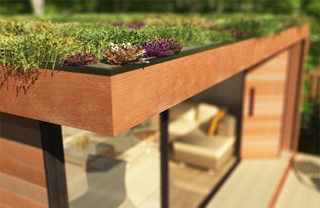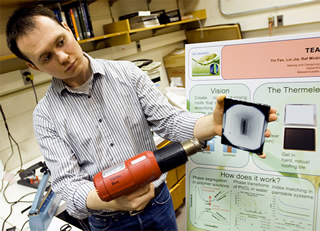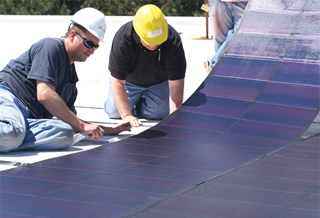New Faces for Old Roofs - Page 3
Pivotal roofing breakthroughs
Foam, single-ply, and modified bitumen roofing systems represent today’s frontline performers among cool-roof solutions for both flat and low-slope roofs. But roofing is an ever-advancing field, and new technology continues to knock at the door.
Often, commercial solutions are re-engineered to work for residential roofs, and scientists are forever tinkering to find better materials that are more efficient and longer lasting, and that have less of an impact on the environment.
Here are three technological breakthroughs that, in recent years, have pointed the way to an evolving future for the roofs that hang over our heads.
Green roofs taking root
 |
|
|
One of those solutions is the green roof. Popular in Europe, and often used for ‘green’ commercial applications, green-vegetated roofs are still in the infant stages for flat-roof residential applications in the United States.
Vegetated roofs are comprised of a membrane topped with soil and a cover of plants. Not only do they reduce the building’s energy consumption and the local heat-island effect, they also absorb rainfall, which reduces urban storm-water runoff.
While new construction can be engineered to accommodate extensive green roofs that have a soil depth of a foot or more, existing residences typically can’t support the weight of the vegetation and soil, particularly when they are saturated from rainfall. Therefore, existing homes must first be evaluated by a structural engineer to determine their weight-bearing capacity.
Ideally, residences deemed suitable for a green roof would have a soil depth of two to four inches to accommodate herbs and sedums—low-growing, shallow-rooted, drought-tolerant plants. The soil is specially prepared to use lightweight matter.
These roofs typically need to be weeded a few times a year and fertilized once a year, according to Green Roof Technology, provider of green roofs in Baltimore, Maryland.
The firm says that green roofs can be built on structurally sound flat roofs with waterproofing that is five years old or less. The plants can be installed with vegetated mats that roll out, modular planters, or a built-up system that uses loose-laid soil.
No matter the system, Green Roof Technology reports, the vegetation will help to protect the underlying roof material from UV radiation, allowing it to last decades longer than a membrane exposed to the elements—as long as the membrane is resistant to root growth.
It’s a Thermeleon chameleon
 |
|
|
Students at the Massachusetts Institute of Technology have experimented with a cool-roof solution that would allow a roof’s surface to change with the weather. Like a retro mood ring, Thermeleon roof tile turns white when it’s hot, and black when it’s cold.
The tiles use commercial polymers and solvents that are encapsulated between a clear plastic top layer and a black backing layer. When cold, the polymer remains dissolved in the solvent, letting the black backing show through. When it gets hot, the polymer condenses into a white, heat-reflecting surface.
The group is still gauging interest from the market, while it is also exploring other options, including a mixture that can be painted or sprayed onto existing roofs.
Rolling out solar...on a roll
 |
|
|
In our efforts to reduce the carbon footprint, a rooftop solar system is an addition that many homeowners have looked to invest in. Rigid and bulky, solar panels are not always the most attractive solution. That’s where the concept of roll-up solar panels comes in.
Xunlight, an Ohio-based solar technology company recently acquired by ILAND Green Technologies of Switzerland, developed a way to make large, flexible solar panels that form thin-film amorphous silicon solar cells on thin sheets of stainless steel.
As opposed to conventional silicon solar panels, which are bulky and rigid, these lightweight, flexible sheets (1.5 millimeters thick) can easily be integrated into roofs and building facades and even vehicles. Amorphous silicon thin-film solar cells can be cheaper than conventional crystalline cells because they use a fraction of the material.




